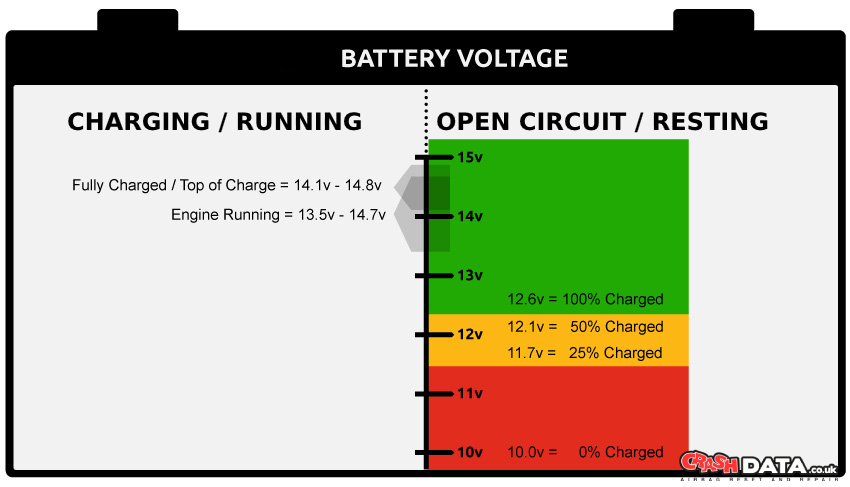Understanding Battery Voltage and How it Affects your Airbag Module

Ever wondered how battery voltage issues can mess with your car’s airbag modules? When your car’s battery isn’t providing the right voltage, it can cause the airbag system to malfunction. This means the airbags might not deploy when you need them most. Low voltage or fluctuations can stress out the electronic components in the airbag module, making them less reliable over time. Plus, a weak battery or a faulty alternator can trigger that annoying airbag warning light on your dashboard. So, keeping your battery and alternator in good shape is crucial for your safety! Regular checks and maintenance can help ensure your airbags are ready to go when you need them.
Low or fluctuating battery voltage can cause the airbag system to malfunction, leading to incorrect readings and potential failure to deploy during an accident. Also, a weak battery or faulty alternator can trigger the airbag warning light on your dashboard, indicating issues within the airbag system. Any recent battery changes or disconnections can also cause the airbag light to come on, this would require the module to be reset to ensure proper functioning.
Maintaining a healthy battery can help ensure your vehicle safety system remains reliable and ready to protect you in the event of an accident. It’s recommended that your test your battery regularly and replace it if it’s failing or has a low voltage. Avoid extreme temperatures when possible, keeping your battery away from extreme heat or cold can help to prevent damage.
How do I use a multimeter to test a car battery?
Testing a car battery with a multimeter is a simple process. The first thing to do is make sure you can access the two terminals on the top of the car battery.
Car batteries are commonly located in the engine bay to one side of the engine, and often have a plastic cover which will unclip, lift off, or occasionally require the removal of a couple of bolts. There may also be a cover over the positive (+) terminal, which usually lifts off.
Once the car battery is exposed be careful that nothing metal touches the terminals, so don’t rest any spanners or other tools on it.
Using your multimeter, you want to measure DC voltage (this is indicated with a solid line and a dashed line above a letter “V”. Set the dial to 20. This will allow you to accurately measure 0-20 volts.
Hold the red probe to the positive terminal and the black probe to the negative terminal. The terminals will be marked ‘+’ and ‘-‘. If you’re getting a reading with a minus in front of it (-12.6 rather than 12.6) you’ve got the probes the wrong way round.

The resting voltage should ideally be no lower than 12.6V. Bear in mind that when a battery goes down to 12.2V it’s actually only 50% charged, and below 12V it’s classed as discharged.
What do I do if the car battery is repeatedly going flat?
If the battery is continually going flat, it could be because of a ‘parasitic loss’. This is where something electrical – a light or a motor for example – is draining the battery, even with the engine turned off. Apart from doing the obvious (setting your phone to record video before you place it in the boot or glovebox to see if the bulb is staying on), you can either remove the leads from the battery, or remove it from the car entirely.
Then, fully charge the battery, leave it for 12 hours and test it. If the battery holds a charge when it’s not connected to the car, it’s not faulty.
How do I test a car battery for dead cells?
Many new car batteries are of the sealed ‘maintenance-free variety. But some older batteries allow you to access the individual cells. The cells will either have individual caps, or a plastic cover that clips over all, or some of the cells.
The cells contain a mix of water and sulphuric acid, so you don’t really want to be messing around inside them too much.
You can buy a hydrometer-style battery tester that measures the specific gravity of the battery acid, and can tell you whether any cells are ‘dead’ or not.
However knowing a cell is ‘dead’ is of no more use to you than knowing that the battery won’t hold a charge, so a test of the resting voltage is just as effective a diagnosis.
Will cold weather affect my car’s battery?
Very cold temperatures will harm a lead-acid or glass mat battery’s ability to hold its charge, but the biggest enemy during the winter is the demand that’s placed on it by heated screens, the car’s heater, heated seats, headlights, heated steering wheel and so on.
If you make lots of short journeys in the winter with lots of these electrical extras turned on, the alternator is going to struggle to get enough charge back into the battery – and next time you try to start the car there may be zero charge left.

